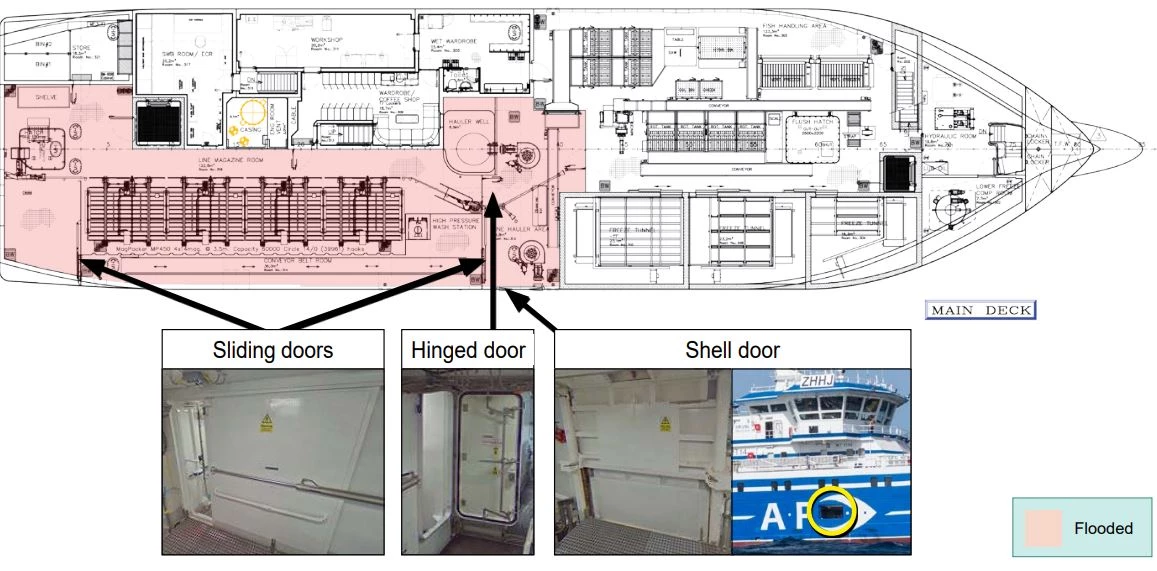Según reporta un informe preliminar emitido por un organismo oficial del Reino Unido, el hundimiento del pesquero Argos Georgia que se produjo el 22 de julio de este año, ha sido atribuido a una vía de agua que ingresó por una puerta de casco en el lado de estribor.
Así lo describe un reporte preliminar emitido por la Maritime Accident Investigation Branch (MAIB), un organismo oficial del Reino Unido. El documento es muy relevante, pues pese a su carácter provisional, es la primera evaluación oficial del siniestro.
El accidente tuvo lugar mientras la embarcación navegaba desde Puerto Argentino, en las Islas Malvinas, hacia los caladeros cercanos a la isla de Georgia del Sur. En ambos casos, aguas argentinas bajo el dominio colonial británico.
En el fatídico suceso, de los 27 tripulantes a bordo, 13 trabajadores perdieron la vida, mientras que 14 sobrevivientes fueron rescatados en una compleja operación de búsqueda y rescate que involucró medios aéreos y marítimos
¿Por qué se hundió un buque tan moderno como el Argos Georgia?
Según los investigadores, una compuerta lateral del casco, que inicialmente se encontraba cerrada, se fue abriendo lentamente hasta quedar completamente abierta. Esto permitió que una gran cantidad de agua inundara el compartimiento de arrastre de estribor, causando un aumento progresivo en la escora del buque hacia ese lado. El informe señala que el equipo a bordo no pudo volver a cerrar la puerta una vez abierta, lo que complicó aún más la situación.
El informe describe cómo la tripulación, al notar el ingreso descontrolado de agua, intentó movilizarse para controlar la inundación. Sin embargo, las puertas internas que comunicaban con otras áreas del barco estaban abiertas, lo que permitió que el agua se extendiera rápidamente a otras zonas de la nave, lo que provocó una inclinación creciente que terminó por hacerla zozobrar.

Infografía del MAIB sobre el hundimiento del Argos Georgia
Las condiciones meteorológicas también contribuyeron a la gravedad del incidente. En el momento del naufragio, el Argos Georgia enfrentaba olas de hasta 7 metros y vientos que superaban los 50 nudos. Tras la alerta emitida por el capitán, la operación de rescate se activó con el apoyo de barcos pesqueros cercanos y equipos de emergencia de las Islas Malvinas.
El informe de la MAIB destaca varios puntos críticos que llevaron a la tragedia. Entre ellos, se menciona que el mecanismo de cierre de la puerta del casco no fue efectivo para mantenerla cerrada en el momento del accidente. Además, las puertas internas del compartimiento de arrastre, al estar abiertas, facilitaron el flujo de agua hacia otras partes del barco. La tripulación, incapaz de controlar el paso del agua, se vio obligada a abandonar el barco poco antes de que se hundiera por completo.
Es decir, hubo un error mecánico en la compuerta exterior -que no cerró- pero también un error humano al dejar abiertas otras compuertas internas que permitieron la entrada de más agua.
El pesquero perdió propulsión alrededor de las 14:45 de este 22 de julio, y en las horas siguientes, la situación empeoró hasta que la tripulación, viendo que la popa comenzaba a sumergirse, optó por evacuar en balsas salvavidas. Para las 11:30 del día siguiente, 23 de julio; dos embarcaciones de rescate habían logrado recuperar a 14 sobrevivientes y los cuerpos de nueve víctimas.
Las investigaciones sobre el accidente del navío abanderado bajo una jurisdicción de conveniencia, Santa Helena, continúan, y las autoridades británicas dicen que esperan obtener más detalles para esclarecer completamente las circunstancias que llevaron a esta tragedia marítima.
¿Estaban al día las inspecciones responsabilidad de la armadora?
El pesquero Argos Georgia era propiedad de una empresa británico-noruega con una larga trayectoria en la industria pesquera. Estaba vinculado a la armadora Argos Froyanes, una compañía con más de tres décadas de experiencia en el sector.
La parte nórdica estaba vinculada a Ervik Ocean, una empresa noruega que posee otros dos pesqueros similares: el Argos Helena y el Nordic Prince.
Uno de los aspectos que deberán determinar futuras investigaciones es si la armadora tenía al día las inspecciones del barco y si eso tuvo alguna incidencia en los problemas de la compuerta. La investigación británica también cuenta con imágenes del palangrero poco antes de hundirse, como muestra la publicada por el MAIB junto al informe.
Fuente:






